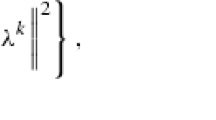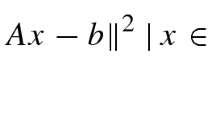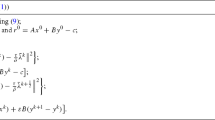Abstract
In this paper, we propose a new customized proximal point algorithm for linearly constrained convex optimization problem, and further extend the proposed method to separable convex optimization problem. Unlike the existing customized proximal point algorithms, the proposed algorithms do not involve relaxation step, but still ensure the convergence. We obtain the particular iteration schemes and the unified variational inequality perspective. The global convergence and \({\mathcal {O}}(1/k)\)-convergence rate of the proposed methods are investigated under some mild assumptions. Numerical experiments show that compared to some state-of-the-art methods, the proposed methods are effective.






Similar content being viewed by others
Notes
The mapping F(w) is affine with a skew-symmetric matrix, and thus it is monotone; see He and Yuan [23]
References
Moreau, J.J.: Proximité et dualité dans un espace hilbertien. Bull. Soc. Math. Fr. 93, 273–299 (1965)
Rockafellar, R.T.: Monotone operators and the proximal point algorithm. SIAM J. Control Optim. 14(5), 877–898 (1976)
Bertsekas, D.P., Tseng, P.: Partial proximal minimization algorithms for convex programming. SIAM J. Optim. 4(3), 551–572 (1993)
Kaplan, A., Tichatschke, R.: Proximal point methods and nonconvex optimization. J. Glob. Optim. 13(4), 389–406 (1998)
Martinet, B.: Brève communication. Regularisation, d’iné quations variationelles par approximations succesives. ESAIM-Math. Model. Numer. Anal.-Model. Math. Anal. Numer 4(R3), 154–158 (1970)
Kassay, G.: The proximal points algorithm for reflexive Banach spaces. Stud. Math. 30, 9–17 (1985)
Güler, O.: New proximal point algorithms for convex minimization. SIAM J. Optim. 2(4), 646–664 (1992)
Spingarn, J.E.: Partial inverse of a monotone operator. Appl. Math. Optim. 10(10), 247–265 (1983)
Han, S.P.: A decomposition method and its application to convex programming. Math. Oper. Res. 14(2), 237–248 (1989)
Zhu, M., Chan, T.: An efficient primal-dual hybrid gradient algorithm for total variation image restoration. UCLA CAM. Rep. 34, 1–29 (2008)
He, B.S.: PPA-like contraction methods for convex optimization: a framework using variational inequality approach. J. Oper. Res. Soc. China 3(4), 391–420 (2015)
He, B.S., Fu, X.L., Jiang, Z.K.: Proximal point algorithm using a linear proximal term. J. Optim. Theory Appl. 141(2), 299–319 (2009)
He, B.S., Yuan, X.M., Zhang, W.: A customized proximal point algorithm for convex minimization with linear constraints. Comput. Optim. Appl. 56(3), 559–572 (2013)
Hestenes, M.R.: Multiplier and gradient methods. J. Optim. Theory Appl. 4(4), 303–320 (1969)
Powell, M.J.D.: A method for nonlinear constraints in minimization problems. Optimization 5(6), 283–298 (1969)
Rockafellar, R.T.: Augmented Lagrangians and applications of the proximal point algorithm in convex programming. Math. Oper. Res. 1(2), 97–116 (1976)
He, B.S.: Parallel splitting augmented Lagrangian methods for monotone structured variational inequalities. Comput. Optim. Appl. 42(2), 195–212 (2009)
Glowinski, R., Marrocco, A.: Analyse numerique du champ magnetique d’un alternateur par elements finis et sur-relaxation ponctuelle non lineaire. Comput. Meth. Appl. Mech. Eng. 3(1), 55–85 (1974)
Gabay, D., Mercier, B.: A dual algorithm for the solution of nonlinear variational problems via finite element approximation. Comput. Math. Appl. 2(1), 17–40 (1976)
Gabay, D.: Chapter IX: applications of the method of multipliers to variational inequalities. Stud. Math. Appl. 15, 299–331 (1983)
Douglas, J., Rachford, H.H.: On the numerical solution of heat conduction problems in two and three space variables. Trans. Am. Math. Soc. 82(2), 421–439 (1956)
Cai, X.J., Gu, G.Y., He, B.S., Yuan, X.M.: A proximal point algorithm revisit on the alternating direction method of multipliers. Sci. China Math. 56(10), 2179–2186 (2013)
He, B.S., Yuan, X.M.: On the \(O(1/n)\) convergence rate of the Douglas-Rachford alternating direction method. SIAM J. Numer. Anal. 50(2), 700–709 (2012)
He, B.S., Yuan, X.M.: On non-ergodic convergence rate of Douglas-Rachford alternating direction method of multipliers. Numer. Math. 130(3), 567–577 (2014)
Sarkis, J.: A strategic decision framework for green supply chain management. J. Clean. Prod. 11(4), 397–409 (2003)
Wu, Z., Pagell, M.: Balancing priorities: Decision-making in sustainable supply chain management. J. Oper. Manag. 29(6), 577–590 (2011)
Yazdani, M., Zarate, P., Coulibaly, A., Zavadskas, E.K.: A group decision making support system in logistics and supply chain management. Expert Syst. Appl. 88, 376–392 (2017)
Gu, G., He, B.S., Yuan, X.M.: Customized proximal point algorithms for linearly constrained convex minimization and saddle-point problems: a unified approach. Comput. Optim. Appl. 59, 135–161 (2014)
Cai, J.F., Candès, Emmanuel J., Shen, Z.: A singular value thresholding algorithm for matrix completion. SIAM J. Optim. 20(4), 1956–1982 (2008)
Tao, M., Yuan, X.M., He, B.S.: Solving a class of matrix minimization problems by linear variational inequality approaches. Linear Alg. Appl. 434(11), 2343–2352 (2011)
Acknowledgements
The authors are very grateful to Doctor Wen-Xing Zhang at University of Electronic Science and Technology of China for his help on numerical experiments on image processing problems. This work was also supported by the Science and Technology on Communication Information Security Control Laboratory, Xiangtan University.
Author information
Authors and Affiliations
Corresponding author
Additional information
Communicated by Majid Soleimani-damaneh.
Publisher's Note
Springer Nature remains neutral with regard to jurisdictional claims in published maps and institutional affiliations.
This work was supported by the Natural Science Foundation of China with Grants 11571074 and 11726505.
Rights and permissions
About this article
Cite this article
Jiang, B., Peng, Z. & Deng, K. Two New Customized Proximal Point Algorithms Without Relaxation for Linearly Constrained Convex Optimization. Bull. Iran. Math. Soc. 46, 865–892 (2020). https://doi.org/10.1007/s41980-019-00298-0
Received:
Revised:
Accepted:
Published:
Issue Date:
DOI: https://doi.org/10.1007/s41980-019-00298-0
Keywords
- Convex optimization
- Separable convex optimization
- Customized proximal point algorithm
- Global convergence
- \({\mathcal {O}}(1/k)\)-convergence rate




